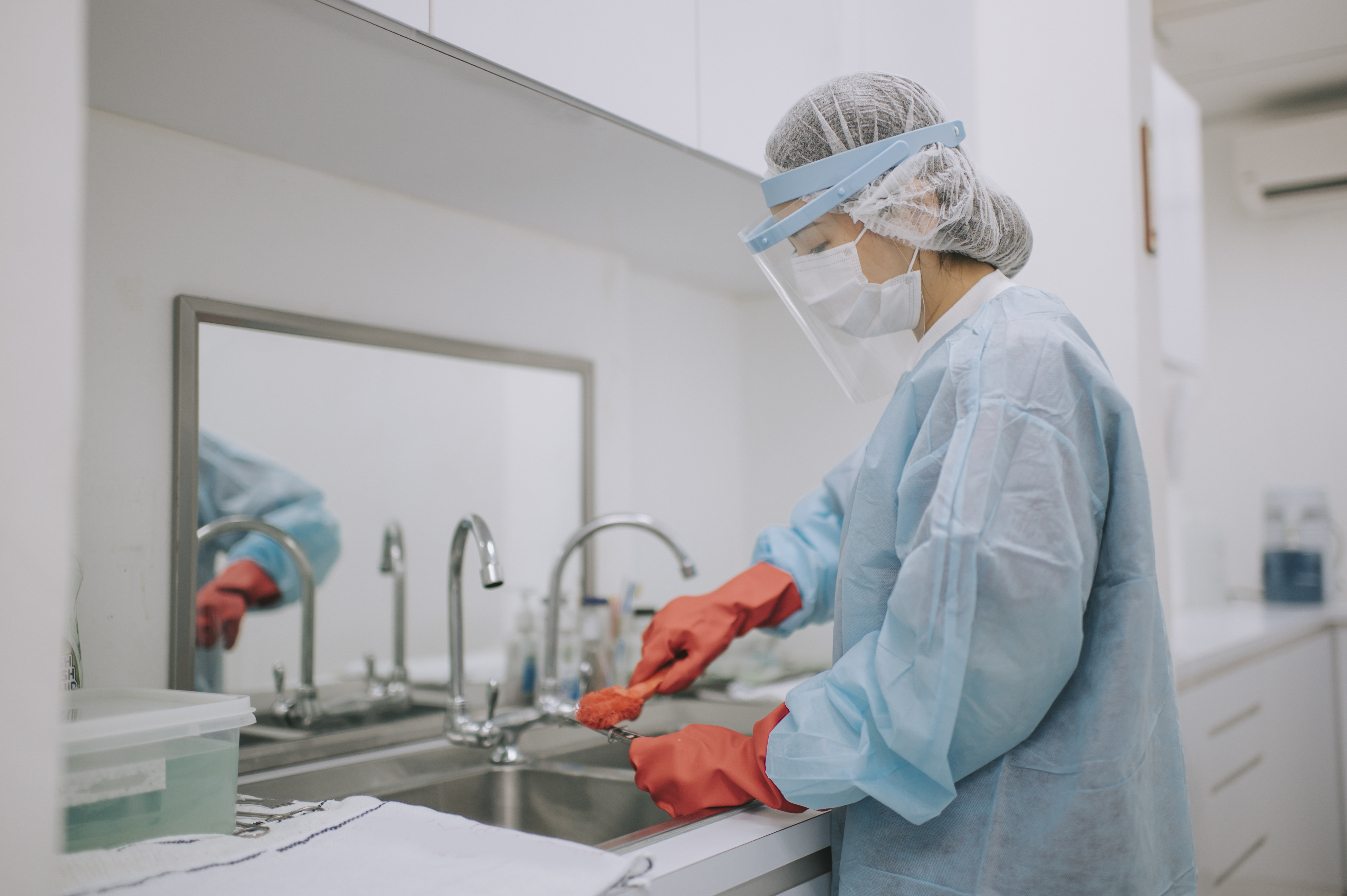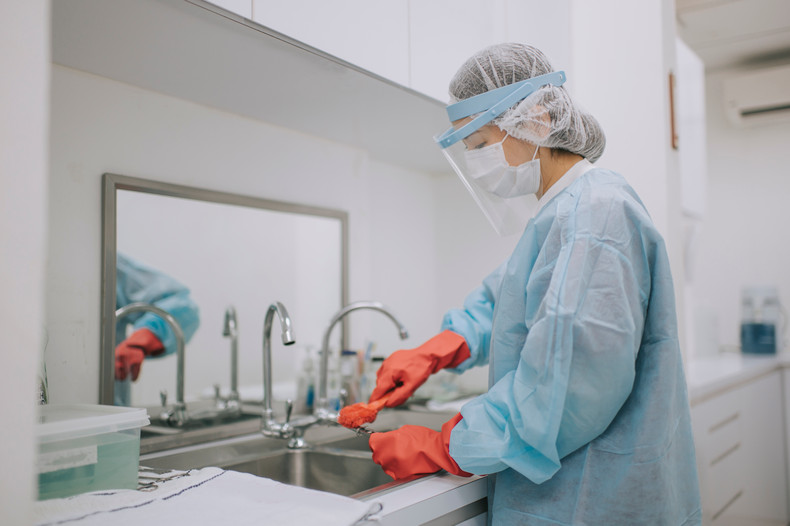
When they coined the phrase the devils in the details, they might have been talking about processing instrumentation for surgery. Most especially, those delicate and fine-tipped instruments that get stuck in the mesh pan, like forcep tips that get bent or even technicians stuck by a skin hook. Sterile processing technicians must be precise and thorough, and every task that they perform is ALL ABOUT the details. This article will share some common and BEST PRACTICES for handling instrumentation during the assembly phase of sterilizing a tray.
INSTRUMENT FORGING AND AAMI RECOMMENDATIONS
A surgical instrument has many steps to get to a manufactured product. Once the instrument is forged, it is placed in a passivation process and a layer is created to protect the metal from staining and promote corrosion resistance. The passivation layer protects the stainless surgical steel and strengthens the instrument during the sterilization process. The more it is sterilized, the stronger it becomes.
Instruments are classified with different metal grades, including floor grade, 300 series called Austenitic, 400 series Martensitic, and others. The passivation layer and the grade of instrument both play a significant role in the do’s and don’ts of assembling an instrument tray.
We begin with ANSI/AAMI ST79: 2017 Comprehensive Guide to Steam Sterilization and Sterility Assurance in Healthcare Facilities 6.3.5 Prevention of instrument damage.The rationale that AAMI provides in protecting instrumentation is that “instrument damage is often due to care and handling issues. Proper preparation at the point of use reduces instrument damage. Instruments can shift during transport. Keeping the instrumentation in an orderly fashion will help prevent instrument damage.”
ASSEMBLY TABLE PROTECTION
Once the sterile processing technician has begun the assembly stage, removing the instruments from a mesh pan can and should be task driven. The items should be removed by hand to protect delicate instruments. Those with delicate tips should be placed on a matted surface, and protected on what mostly are stainless steel assembly tables. As we travel around the country and audit different sterile processing departments, we often see the common technique of standing the mesh pan full of instruments on its side and dumping the instruments onto a metal table. With the information provided previously in this article and what we know about stainless steel instruments, this technique can damage the instruments significantly.
Think of how we place instruments within a tray. We protect the instruments from moving or shifting while in the container with a rubber mat or a non-laundered towel. This also prevents metal to metal contact. The rationales for protecting the instruments during transport and storage to reduce possible damage may apply to the metal assembly table.
DUMPING
When interviewing Jhmeid Billingslea, Managing Director of Surgical Services for Advantage Support Services, he stated, “A common practice with unintended consequences is dumping cleaned instrument tray contents on workstations. Emptying the instrument basket is an essential step in assembling a tray that under ideal circumstances is achieved by carefully removing each instrument one at a time. The downfall of this, of course, is that this would add time to the processing cycle. Every technician will tell you that they "never" dump trays out, but an eye level inspection of most workstations will reveal multiple dents and uneven spots that represent two-way damage to the surface and the instruments poured onto the table top. The most realistic solution is to provide padded “disinfectable” pads for each workstation. These pads are a superior option to hospital linen because they do not carry the risk associated with reusable linen and they can also have measuring parameters and assembly tips printed directly on the pads.”
FIND YOUR PROCESS
Every technician has their own ritual during assembly, which is a good practice. However, each processing professional that has their own process may miss important steps during packaging. As we all know, there are several steps in this part of the instrument process to produce a quality tray.
As a past surgical technician, my process when assembling is to roll a towel, and place the instruments from the mesh pan onto the rolled towel. I then place them in the order that the count sheet will call for, as best I can. This manner of handling instruments takes time and as we know, that time is often evaluated. We must, as professionals, work efficiently and effectively to achieve our goals. It is a great benefit to be part of a department that balances quality and quantity so that the technician can take the time to process the tray correctly.
To process a tray of instruments correctly during the assembly stage, one of our first goals is to reduce microorganisms or organic material from the surface of the assembly table. As an infection prevention advocate, disinfection is one of our main goals. Disinfecting the metal table includes removing a padded mat or huck towels that may be on the table used to place the instrument on. If huck towels or even blue wrap are on the table, those items should be removed and discarded after each tray is completely packaged. This task is performed to fulfill our role in infection prevention to prevent cross contamination from one instrument tray to another. Remember that during assembly these instruments are not sterile, only rendered safe for handling. All debris and bioburden should have been removed during the cleaning and disinfection stage, but as we know we may still find debris from time to time.
Processing packages effectively and efficiently, again determined by the balance in the department, should always be considered.
IN CLOSING
We, at Advantage Support Services, feel privileged to do the work that we do. Having the ability and tools to help hospital departments by auditing processes and educating technicians, we are always grateful for the opportunity to streamline sterilization. In observing the practices of technicians all over the country, we hope to draw attention once more to a specific point of this process. Dumping the instruments onto a table is bad technique. The technician may feel that dumping saves time, but it creates many inefficiencies that will create difficulties in every next step of patient care that follows. As all sterile processing professionals are growing in their craft and developing a culture of excellence, consider integrating best practices into the daily tasks.
References:
ANSI/AAMI ST79: 2017 Comprehensive Guide to Steam Sterilization and Sterility Assurance in Healthcare Facilities
Angela Lewellyn
Director of Development Advantage Support Services

